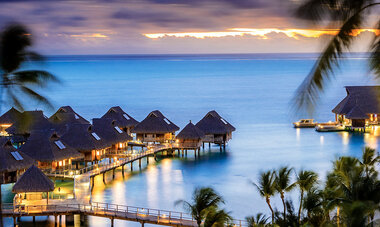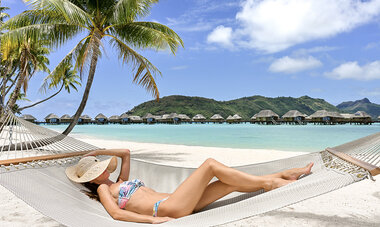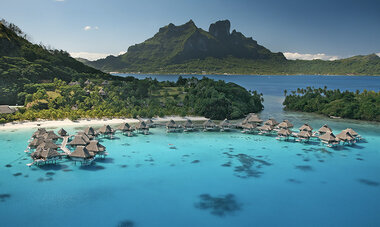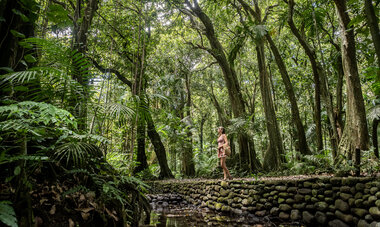
What’s the best time to visit Tahiti ?
What is the best time to go to Tahiti? This question is often asked when considering the weather conditions and your selected holiday period (or simply your kids’ school holidays).
To take full advantage of the Islands of Tahiti, of its mild weather, the sweet temperatures of the lagoon water and the locals' smiles, any month of the year has its share of wonders and festivities.
So, when is the best time to visit Bora Bora and the other islands of Tahiti ? The dry and sunny season, the rainy season, the temperatures, the weather and the crowds... before you travel to paradise, we answer all your questions in this little guide for a perfect trip to Tahiti and Bora Bora.

The Best Season to Visit Tahiti for All Travelers
The Islands of Tahiti are the perfect destination for all seasons, offering a pleasant climate all year round. So, what is the best season to visit the Islands of Tahiti? Here are some facts:
- From November to May, temperatures are higher and humidity increases, marking the rainy season.
- From November to March, the days are longer due to the summer solstice occurring in the Southern Hemisphere.
Nights are cooler and more restful from May to November
Days are less disturbed by the rain during this period : the sunny and dry season (high season for tourism)
These are general trends in temperature, humidity and sunshine for each season. However, you can enjoy beautiful sunny days between November and May, which will allow you to experience the benefits of the low season for tourism: fewer people and overall lower prices for accommodations and excursions. Indeed, in terms of price, fares to Tahiti vary according to the tourist season. Winter in Tahiti can be more budget-friendly. Check the hotels & resorts fares and contact us to choose the best time to visit Tahiti according to your travel budget.
What are the temperatures like in French Polynesia?
The average annual temperature is 79°F, generally varying between 70 and 95°F. A tropical climate that leaves no room for extremes of heat or cold:
- The cool seasons are characterized by air temperatures varying between 70 and 80,5°F. During this period, water average 77°C: the favorite season for most travelers!
- The warmer seasons offer a climate between 77 and 95°F. The water temperature rises to approximately 82°F.
Please note that French Polynesia is extremely vast. So, the weather also differs from one archipelago to another.
The Tuamotu Archipelago (Fakarava, Rangiroa...) enjoys a particularly generous amount of sunshine, so you can avoid rain all year-round, while enjoying pleasant temperatures thanks to the trade winds.
Further south, the Gambier Islands and the Australs Archipelago (Rurutu, Tubuai...) offer a slightly cooler climate than their neighbors, with average temperatures below 77°C.
A calendar of festivities to help you visit Tahiti at the right time
You’re now able to decide, as the local weather is no secret to you anymore. However, it is not the only criteria. We've put together some practical information to help you decide when to go to Tahiti. Follow the guide!
Depending on your personal interests, and the things you want to experience on your tropical adventure, you may want to visit Bora Bora and the Islands of Tahiti to…
Participate in large sports events
Travel to Tahiti in May, to join the Tahiti Pearl Regatta, sailing from the beach of Raiatea to Taha’a (near Bora Bora). It’s one of the most beautiful races in the South Pacific Ocean.
You can also watch the best international surfers compete at the Taapuna Masters. In may, temperatures and tropical weather are particularly mild for a low season since it is the end of the humidity and the beginning of dryer, sunny days.
If you want to take part in the Hawaiki Nui Va'a, go to Bora Bora or Huahine at the end of October. You’ll be able to follow the most beautiful va’a (outrigger canoe) race in the World over three days, divided in three mythical races taking place between Huahine and Bora Bora as the finish line.
Go Whale Watching in The Islands of Tahiti
A day's whale-watching cruise is a magical excursion. From June to the end of October, humpback whales come from the cold Antarctic waters towards the equator and to French Polynesia, the most peaceful place for a whale to give birth and have fun in this 1,76 million square miles marine sanctuary, under protection of the 2002 law.
The sunny months of June to August are the high season for tourism to visit Bora Bora or any island. Choose September and October for mid to low season and equally mild temperature.
Attend the Heiva, Tahiti's Biggest Cultural Festival
The cultural festivities of July are a must. Travel to French Polynesia the first two weeks of July, to enjoy traditional Polynesian dances, an amazing representation of ‘ori Tahiti, at the Heiva i Tahiti, taking place every year in Papeete.
The month of July is dedicated to these festivities as well as to traditional sports competitions. Crowds gather to discover this incredible part of Polynesian culture.
Watch the Big Waves of Teahupo'o During the Tahiti Pro
Just 1h30 from Papeete, Teahupo'o is one of the world's most famous surf spots. Travel in August to watch the best international surfers compete on the mythical waves of Teahupo’o, during the Tahiti Pro. The view of the mountains from the water is absolutely iconic and the atmosphere during the competition is amazing.
Immerse Yourself in Pacific Cultures With FIFO
If you choose to travel to Tahiti in early February, we recommend you attend the magical FIFO week - International Oceanian Movie Festival, a yearly event in Papeete. Your vacation thus becomes a cultural trip to better understand the history and culture of the whole of Oceania.
Which time of the year should you choose for your favorite activities?
In addition to annual events, we advise you to choose your travel dates according to the activities you'd like to enjoy at your destination.
Go snorkeling and scuba diving:
The water temperatures are never low in French Polynesia! The temperature of Bora Bora's lagoon generally oscillates between 22°C and 28°C (71°F to 82°F) during the year. Thus, you can have the pleasure of diving in any season for a snorkeling or scuba diving session during your trip.
In the Society Archipelago, Bora Bora and Maupiti are two of the best snorkeling destinations in the world. The Tuamotu islands, including Fakarava and Rangiroa, are a diver's paradise.
The period from May to October is particularly pleasant for its weather, perfect for a day on the beach or a cruise that stops at all the islands' best snorkeling spots, but French Polynesia offers you the chance to dive all year-round, as the light is always very important, offering you excellent visibility of the sea floor in any season. Scuba diving and snorkeling enthusiasts, get your masks! The tropical fauna of Polynesian waters awaits you.
Go surfing in Tahiti:
Teahupo'o is not the only beach popular with surfers. In Tahiti, there are waves on various beaches all year-round! You can take advantage of your trip to Tahiti to discover or even surf the wonderful waves of the west coast beaches, which offers a large swell between May and September. The rest of the year, the waves are on the east coast.
To spend Christmas under the sun:
You should travel to Bora Bora, Tahiti and the other island in December, to leave the cold and cloudy skies and spend the holidays basking in the welcoming Polynesian sun; late December to see Santa paddle boarding on the lagoon to deliver presents, while his reindeers rest on the other side of the world - ;) Isn't this an extraordinary family vacation?
Taste the delicious local products:
During the rain season, the higher humidity allows the fruit trees, vegetables and tuberous plants of Tahiti, Bora Bora, Moorea, Huahine, Raiatea and Taha'a to flourish. This is called the season of abundance. Incredible quantities of tropical fruits are ripening: mangoes, avocados, rambutans... It is a festival of flavors. And the fish too! Indeed, this wonderful season is also a time for fishing : great news for all food lovers.
The land of eternal summer?
Many people ask this question, depending on the weather and the vacation dates they may have (or depending on their children's school vacations). You'll read that it's always summer in Tahiti. That's not quite true. Let's go back to the myth of the islands' creation.
The Polynesian Myth That Started it All
In the beginning, Ta'aroa, creator of all Polynesian people, created every island. His son Tane was God of the Sky. But he didn’t like to see it so plain. So, Ta’aroa gave him thousands of pearls that he got from pearl oysters spread across the Tuamotu lagoons and today, they represent the unrivaled pearls of Tahiti. Tane was so excited that he spread them throughout the sky. These pearls became the shining stars that light up the sky. He kept the 10 most beautiful pearls in his hand. He arranged 4 of them in an X shape high in the sky. In the future, sailors will call these stars the Southern Cross.

The Pleiades Pearls: A Polynesian Tale
He then threw the remaining six pearls into the horizon. They gathered with a group of another hundred pearls and created the Pleiades, Matari’i in Tahitian. Then they disappeared instantly. Tane stood by. They soon reappeared on the horizon, matari’i i ni’a, the high stars, in a rise that brought wealth and fertility to the islands and lagoons. Six months later, they disappeared again, matari’i i raro, the low stars, creating drought and famine. This is how the seasons were created on the islands of the great ocean.
Don’t worry, you will not experience any drought or famine during your stay, but the weather is definitely dryer from May to November, with cooler nights and a colder lagoon than between December and April. But don't worry about your stay in Tahiti: we remind you that the minimum temperature average between 68 and 72°C : perfect for any vacation!
Golfing at the Green Pearl
For golf enthusiasts, October and November are the months to participate in the golf Laplace trophy (2 days) or in the Moorea trophy (3 days), offering multiple original and friendly game options.
Running a marathon
End of February (24 and 25th in 2023), to run the Moorea Marathon, first created in 1988. 4 options are offered (5, 10, 21.1 and 42.195 kms), for all ages and any levels. A 4.5 km “Color run” is organized at the same time, for a fun run or walk.
Follow a mythical canoe race
In July, to be part of the mythical Fa’Ati Moorea canoe race (Va’a V6) between Tahiti and Moorea, more than 56 miles during which canoes and their crews are highly challenged.
Tattoos
In September, to discover the Tatoo festival in Tatau, Moorea.
To excel in a race in tropical weather
End of May, to compete in the XTerra Tahiti Trail, choosing between three surprising races (not to mention the junior discovery race), including the XTerra Tupuna Trail, a strenuous loop of 27 miles long and more than 2200 meters of elevation gain.
In June
Travel to Bora Bora in June to enjoy traditional Polynesian dances, an amazing representation of ‘ori Tahiti. The Heiva i Tahiti competition is held in July. But the Heiva i Bora Bora is a particularly interesting opportunity to discover the culture of the island in a charming and authentic setting, and in perfect weather. If you visit Bora Bora at this time, don't miss this event.
At the end of October
Visit Bora Bora at this time of the year to follow the most beautiful va’a race in the World over three days, divided in three mythical races taking place between the island of Huahine and Bora Bora as the finish line, along Matira Beach.
In September
To take part or watch the Maraamu Surf Ski race, a 21,7 miles kayak race, starting in Taha’a and arriving in Vaitape, the main village of Bora Bora.
Between July and October
Visit Bora bora during the whales season in French Polynesia, to watch the humpback whales having fun in the Ocean, and sometimes even inside the lagoon. Bora Bora is a particularly important island for whales, which come in great numbers to raise their babies. You will have a good chance to observe them.
In January
Travel to Bora Bora just after the holiday season to experience the Ta’urua Vārua’s unique ceremony in French Polynesia. This “Spirits celebration” gathers the island’s three Protestant parishes: Faanui, Anau and Nunue (Vaitape).
Arts Festival
Travel around mid December to feel the Marquesian “mana” (Tahitian for spirit) during the Arts Festival at Nuku Hiva (Hatiheu)
Paul Gauguin
Travel in May, to celebrate the 120th anniversary of Paul Gauguin’s death (May 8, 1903), in Atuona on the Island of Hiva Oa. Left of his grave, Jacques Brel’s resting place will be honored to receive your visit.
A different weather
Compared to the Society Islands, the Marquesas Islands’ subtropical climate is warmer and more humid, due to their closer proximity to the Equator. March and April are usually the rainiest months. Note also that the islands located in the South are more humid than the ones in the North of the archipelago. Due to this different weather, the dryer season is between August and December.
The name (Australe) gives you a hint about their location: they are the most Southern Islands of Polynesia. Further South, about 4350 miles, is the Austral continent or Antarctic.
This is the chilliest location in Polynesia with temperatures in winter (June-September), going down to below 15°C (7°C maximum was recorded on Sep. 21, 1974)
Rainy Season
January to April are the months with the most precipitations (1800 mm per year), but this shouldn’t stop the explorer in you.
By default, we recommend visiting the Australs Islands between November and April. A perfect timing, as December-January is also the season of lychees, and other specialties of these Islands where everything grows, from carrots to peaches, apples and all citrus fruits.
The Australs Islands are considered the Mother Earth of Polynesia. The perfect place if you’re looking to combine a healthy diet of fresh products taken straight from the land or the ocean, with a fascinating discovery of pre-European’s traces.
Bounty
April in Tubuai is time for commemoration of the mutineers’ arrival onboard the HMS Bounty, guided by Fletcher Christian on April 28, 1789. It is also the opportunity to go back to this historical moment before their final settlement in Pitcairn in January 1790.
Humpback Whales
From July to October, humpback whales travel from the Antarctic (during intense cold season) to the North Pacific to give birth. Especially true in Rurutu, these majestic Cetaceans offer an amazing show.
Lychees
December is the best month for a gourmet visit of Tubuai, when it’s time to harvest lychees, the best ones you’ve never tasted before.
Festival
Eventually, there is a festival not to be missed that takes place every 4 years in the Australs Islands.
You’ll need to be patient until next time as the last one took place in Tubuai in November 2022. The next one is scheduled for November 2026, on Rimatara’s island.


